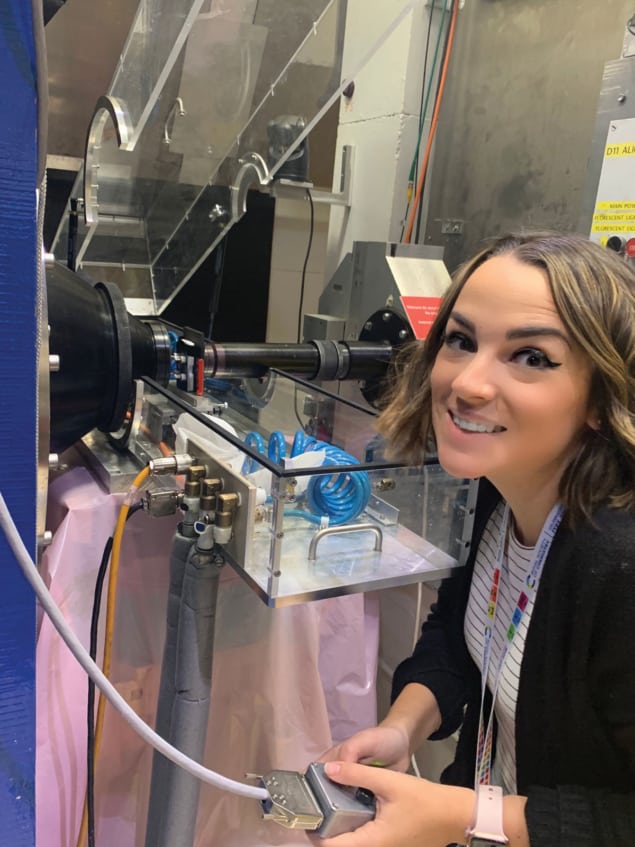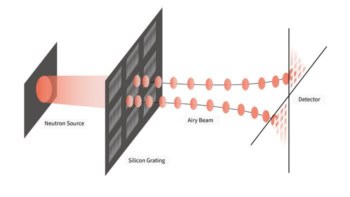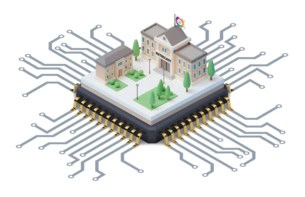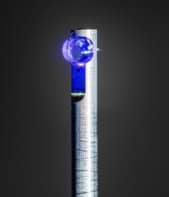Emily Draper of the University of Glasgow uses neutrons to study self-assembly and has been awarded the BTM Willis Prize for her contributions to the field. She speaks to Hamish Johnston about her research

What materials do you study
My research group is looking at small organic molecules – normally based on dye molecules that we functionalize using amino acids. These molecules are designed to self-assemble in water to create a variety of structures. The molecules are conductive, and we are interested in how we can use different structures to make conductive devices for various applications.
What are some potential uses for these structures?
We are focused on three different types of applications. One involves chromic materials, which change colour upon either light stimulation or electrical stimulation. These materials can be used in smart windows such as those you see in modern aeroplanes – where the switch of a button darkens the windows. We are also looking at organic semiconductors, which are thin-film materials.
More recently, we have been making flexible thin-film devices that change their conductivity upon bending. These could be used to monitor muscle movement on the body with applications such as tocodynamometers, which monitor uterine contractions during pregnancy.
What are the benefits of using self-assembly to make devices?
Traditional devices are made from metals, which only assemble in a limited number of ways. Furthermore, the world is running out of metals, and they must be processed at high temperatures, which makes them expensive. Our self-assembly processes are done at room temperature in water, using simple molecules that can be easily made in large quantities. No dangerous chemicals or high temperatures are needed – it is very environmentally friendly.
You use small angle neutron scattering (SANS) to study these materials. How does that work?
SANS is done at a large-scale neutron facility such as the Institut Laue Langevin (ILL) in Grenoble, France. We put a sample into a neutron beam and then collect the neutrons that have scattered at small angles. This allows us to study the structure of a sample from the molecular length scale all the way up to the bulk scale.
SANS is important for my research because our materials are not appropriate for electron microscope studies – the organic molecules would be destroyed by the electron beam.
What are the pros and cons of using large neutron facilities?
An important benefit of using a large facility like ILL is that there are many experimental stations on the neutron beamline that you can use to do a variety of measurements. Also, the neutron flux is very high so you get really great data.
Another benefit is that the facility is used by a wide range of scientists – not just chemists – so the conversations you have over dinner can be very interesting. Working with the facility’s beamline scientists is also an important plus – they are experts in their fields who can give you loads of new research ideas.
One of the downsides is that you have to use your allotted beamtime 24 h a day. That means long, tiring nights – but that normally only lasts a few days. Also, the process of applying for beamtime can be laborious. If your application is successful, you may have to wait six months before you can start – so you need to be thinking ahead all the time of the experiments that you want to do.
A big plus for ILL visits is being in Grenoble. It’s really pretty and people can go skiing
Do you and your research group enjoy working at big facilities like ILL?
I was so excited when I was doing my postdoc and I got to go on my first beamline experiment. Being at a huge facility is completely different from working in a typical chemistry lab under a fume hood. It can be a bit scary at first with the safety protocols and the radiation dosimeters, but it’s quite cool and something that my team enjoys doing. And a big plus for ILL visits is being in Grenoble, which is in the middle of the mountains. It’s really pretty and people can go skiing.
Unfortunately, ILL has been closed for the lockdown and all our beamtime has been postponed or cancelled – so lots of my team haven’t been there yet. But recently I was able to send one of my PhD students to the ISIS neutron facility in Oxfordshire and she absolutely loved it.
Looking to the future, are there any new or planned neutron facilities that you are looking forward to using?
The European Spallation Source (ESS), which is being built in Sweden, looks interesting. I know that the ESS has been engaging with the neutron community to develop some exciting experimental stations. One technique that I am really interested in using is ultra-small-angle neutron scattering (USANS), so having new facilities for that would be great.
At current facilities, I enjoy working with beamline scientists to develop new experiments and instruments on existing beam lines. I love doing rheology, so developing experiments for that is something that I am interested in. The beamline scientists we work with at ILL trust me and team, so we can do all kinds of wacky experiments and I’m really appreciative of that.



